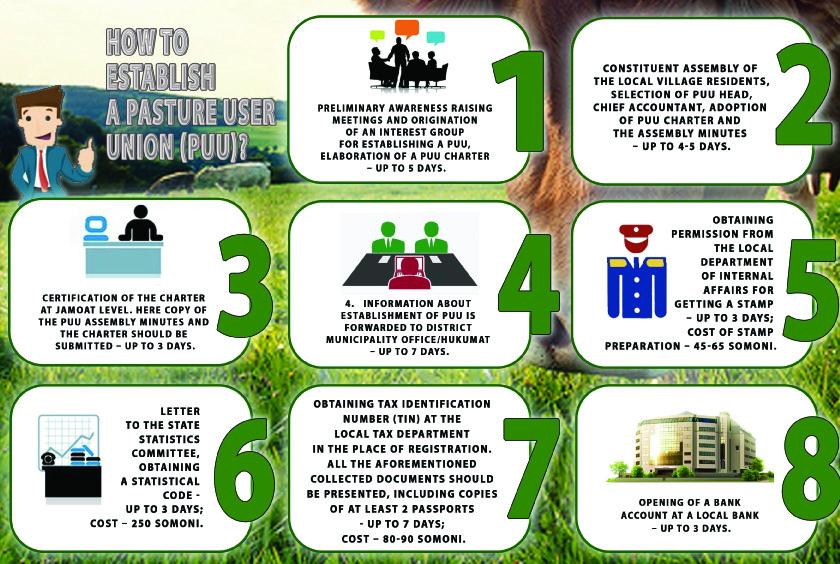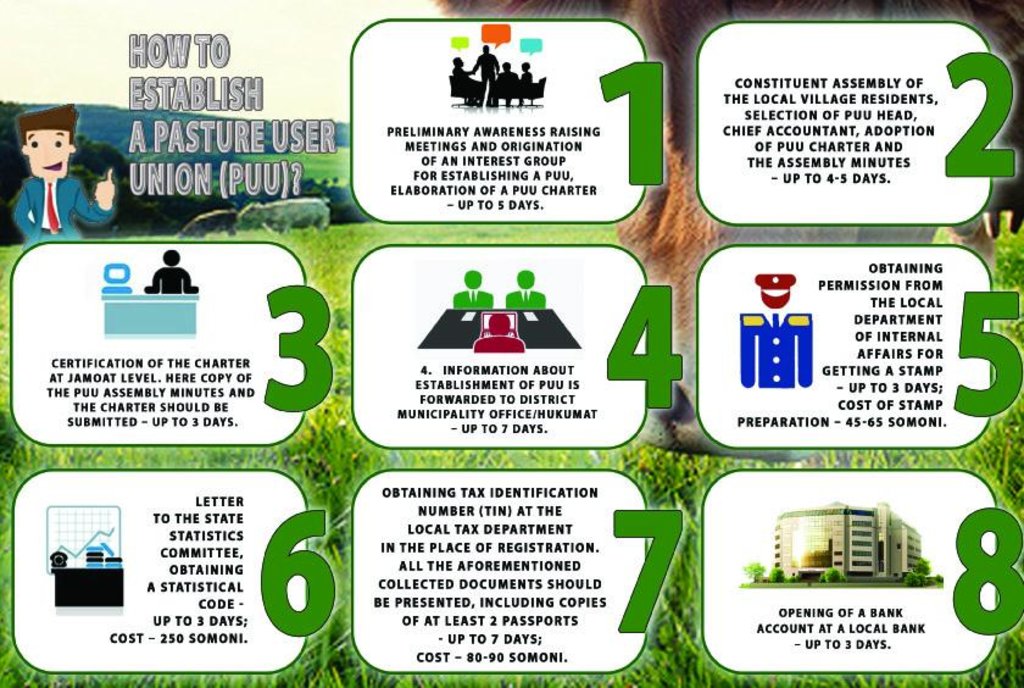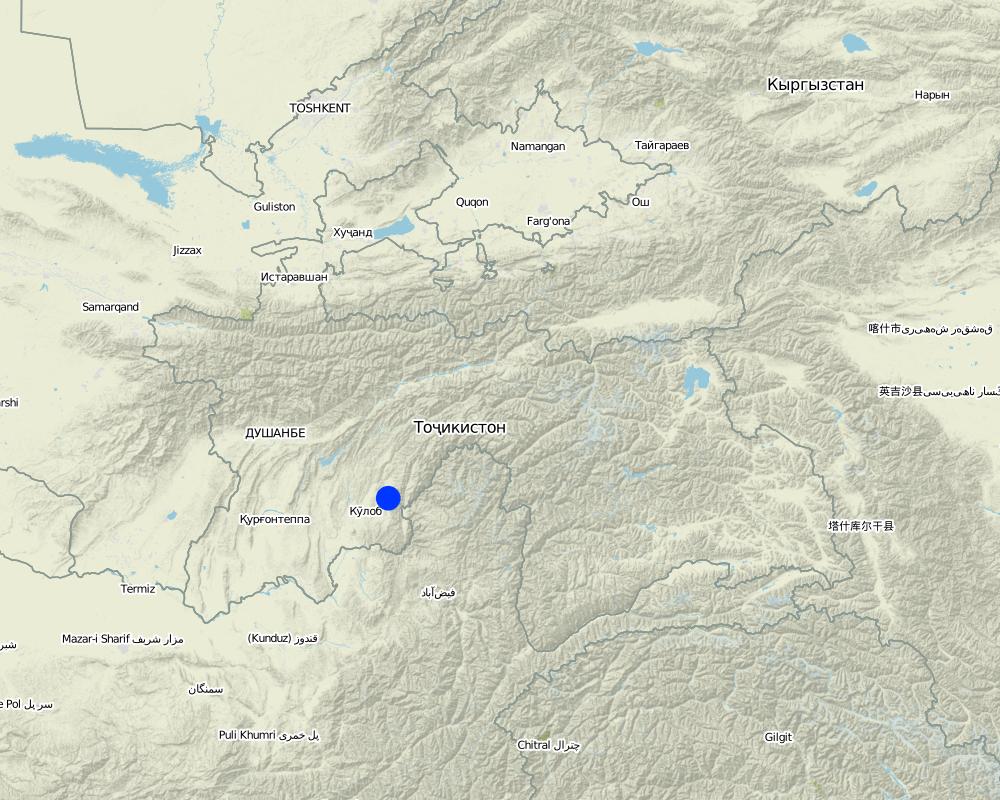Conversion of Village Livestock Committees into the legal Pasture User Unions [Tajikistan]
- Creation:
- Update:
- Compiler: Sa'dy Odinashoev
- Editor: –
- Reviewer: David Streiff
Табдил додани Кумитаи Чорводории Деҳа ба Ҷамияти Чарогоҳ Истифодабарандагон
approaches_2539 - Tajikistan
View sections
Expand all Collapse all1. General information
1.2 Contact details of resource persons and institutions involved in the assessment and documentation of the Approach
Name of the institution(s) which facilitated the documentation/ evaluation of the Approach (if relevant)
CARITAS (Switzerland) - Switzerland1.3 Conditions regarding the use of data documented through WOCAT
When were the data compiled (in the field)?
15/01/2016
The compiler and key resource person(s) accept the conditions regarding the use of data documented through WOCAT:
Ja
2. Description of the SLM Approach
2.1 Short description of the Approach
Livestock committees were established with the goal to improve livestock health as well as natural resource management in the watersheds where the village pastures were situated. Livestock committees in the Muminabad district are organised at village level and coordinate their activities through the registered livestock association at district level.
2.2 Detailed description of the Approach
Detailed description of the Approach:
Aims / objectives: This approach applied by Caritas Switzerland, aimed to improve natural resource management in the watersheds through an organised effort of livestock owners. It encourages preventive measures against soil erosion by providing incentives for beneficiaries at community level. The process is managed by the livestock committees, who represent the animal owners at village level. The committees are responsible for organising livestock owners and managing the village pastures by applying rotational grazing principles, establishment of water points and rest places, ensuring safe paths for animals and easy access to pasture lands.
Stages of implementation: The project encompasses the following steps: 1) Competitive call for project proposals to improve livestock and pasture management through villager's efforts, 2) Expression of interest from community members to participate in the competition, 3) Development of project proposals from villagers with assistance of technical staff from the implementing agency (Caritas), 4) Selection and notification of winners, confirmation of village funding commitments, 5) A village general meeting for the inception of project and laying the foundation for the livestock committee, 6) Formalisation of partnership agreement with donor (signed agreements for project implementation), 7) Project implementation transfer into livestock committee’s responsibility, 8) Technical assistance through training and workshops, monitored by the implementing agency (Caritas), 9) Strengthening of the livestock committee as a community based organisation, 10) follow up and continued activity of livestock committee through other projects and self organised activities among livestock owners
Role of stakeholders: Various locals and village members are essential is assisting with the success of the project; The religious head (mullah) acts as a promoter of idea and mobilises the community through developing villager's interest; the village informal leader (vakil), helps to coordinate the activities; local organisations assist in informing and bringing people together for the meetings. The livestock committee consists of five members, including the appointed head shepherd. This has proven to be an effective size group. The main tasks of this committee include; mapping the pasture lands, organising rotational schemes, informing and training livestock owners of methods to improving pasture grazing, keeping villagers informed, establishing and collecting membership fees, keeping the accounts for the organisation, and application of funds (own or donor’s), develop new ideas and project proposals for further land improvement projects.
Other important information: The villagers are responsible for the labour contribution during the construction of water points or paths/roads. They pay membership fees, which cover the shepherd’s salary and the committee’s activities. They are kept informed of pasture grazing schemes, and control the performance of the committee.
2.3 Photos of the Approach
2.5 Country/ region/ locations where the Approach has been applied
Country:
Tajikistan
Region/ State/ Province:
Tajikistan/Khatlon
Further specification of location:
Muminabad
Map
×2.6 Dates of initiation and termination of the Approach
If precise year is not known, indicate approximate date when the Approach was initiated:
less than 10 years ago (recently)
2.7 Type of Approach
- project/ programme based
2.8 Main aims/ objectives of the Approach
The Approach focused mainly on SLM with other activities
The SLM Approach addressed the following problems: In Soviet time the pastures around the villages were belonging the village, but after the Soviet era all the land become private, individuals started to privatize the pasture lands around the village and people found out only after a month, during the payment day. The pastures belong to one person, if the herd of the village is grazing village have to pay. If the tax for one ha of pasture land is 1 USD, to private people they have to pay per cow 3.5 USD per month.
3. Participation and roles of stakeholders involved
3.1 Stakeholders involved in the Approach and their roles
- local land users/ local communities
- NGO
- national government (planners, decision-makers)
3.2 Involvement of local land users/ local communities in the different phases of the Approach
| Involvement of local land users/ local communities | Specify who was involved and describe activities | |
|---|---|---|
| initiation/ motivation | self-mobilization | |
| planning | none | |
| implementation | none | |
| monitoring/ evaluation | none | |
| Research | none |
3.4 Decision-making on the selection of SLM Technology/ Technologies
Specify who decided on the selection of the Technology/ Technologies to be implemented:
- mainly land users, supported by SLM specialists
Explain:
Decisions on the method of implementing the SLM Technology were made by mainly by land users supported by SLM specialists
4. Technical support, capacity building, and knowledge management
4.1 Capacity building/ training
Was training provided to land users/ other stakeholders?
Ja
Specify who was trained:
- land users
- field staff/ advisers
Form of training:
- on-the-job
- farmer-to-farmer
- demonstration areas
- public meetings
4.2 Advisory service
Do land users have access to an advisory service?
Ja
Describe/ comments:
Advisory service is quite adequate to ensure the continuation of land conservation activities
4.3 Institution strengthening (organizational development)
Have institutions been established or strengthened through the Approach?
- yes, greatly
Specify the level(s) at which institutions have been strengthened or established:
- local
Specify type of support:
- capacity building/ training
4.4 Monitoring and evaluation
Is monitoring and evaluation part of the Approach?
Ja
Comments:
bio-physical aspects were regular monitored by project staff, land users through observations; indicators: None
bio-physical aspects were regular monitored by project staff, land users through measurements; indicators: None
technical aspects were regular monitored by project staff, land users through observations; indicators: None
technical aspects were regular monitored by project staff, land users through measurements; indicators: None
socio-cultural aspects were regular monitored by project staff, land users through observations; indicators: None
socio-cultural aspects were regular monitored by project staff, land users through measurements; indicators: None
economic / production aspects were regular monitored by project staff through observations; indicators: None
economic / production aspects were regular monitored by project staff, land users through measurements; indicators: None
area treated aspects were regular monitored by project staff, land users through observations; indicators: None
area treated aspects were None monitored by project staff, land users through measurements; indicators: None
no. of land users involved aspects were None monitored by project staff, land users through observations; indicators: None
no. of land users involved aspects were None monitored by None through measurements; indicators: None
There were few changes in the Approach as a result of monitoring and evaluation: Involvement of the local mosque.
There were few changes in the Technology as a result of monitoring and evaluation: Setting a side big amount of the pastures.
4.5 Research
Was research part of the Approach?
Nee
5. Financing and external material support
5.1 Annual budget for the SLM component of the Approach
If precise annual budget is not known, indicate range:
- 10,000-100,000
Comments (e.g. main sources of funding/ major donors):
Approach costs were met by the following donors: international non-government: 60.0%; local community / land user(s): 40.0%
5.2 Financial/ material support provided to land users
Did land users receive financial/ material support for implementing the Technology/ Technologies?
Ja
5.3 Subsidies for specific inputs (including labour)
- equipment
| Specify which inputs were subsidised | To which extent | Specify subsidies |
|---|---|---|
| machinery | partly financed | |
| tools | partly financed | |
- agricultural
| Specify which inputs were subsidised | To which extent | Specify subsidies |
|---|---|---|
| seeds | fully financed | |
| fertilizers | fully financed | |
- construction
| Specify which inputs were subsidised | To which extent | Specify subsidies |
|---|---|---|
| stone | fully financed | |
| wood | fully financed | |
If labour by land users was a substantial input, was it:
- voluntary
5.4 Credit
Was credit provided under the Approach for SLM activities?
Nee
6. Impact analysis and concluding statements
6.1 Impacts of the Approach
Did the Approach help land users to implement and maintain SLM Technologies?
- No
- Yes, little
- Yes, moderately
- Yes, greatly
Decreasing of runoff, increase of soil cover, increase of fodder crops and rehabilitation of the gullies.
Did the Approach empower socially and economically disadvantaged groups?
- No
- Yes, little
- Yes, moderately
- Yes, greatly
Did the Approach improve issues of land tenure/ user rights that hindered implementation of SLM Technologies?
- No
- Yes, little
- Yes, moderately
- Yes, greatly
At the beginning the spring where the livestock was drinking water open the livestock were destroying the
Did other land users / projects adopt the Approach?
- No
- Yes, little
- Yes, moderately
- Yes, greatly
Did the Approach lead to improved livelihoods / human well-being?
- No
- Yes, little
- Yes, moderately
- Yes, greatly
Did the Approach help to alleviate poverty?
- No
- Yes, little
- Yes, moderately
- Yes, greatly
6.2 Main motivation of land users to implement SLM
- increased production
Increase livestock production
- increased profit(ability), improved cost-benefit-ratio
- reduced workload
Less working for livestock
- environmental consciousness
- well-being and livelihoods improvement
More income for the farmers
6.3 Sustainability of Approach activities
Can the land users sustain what has been implemented through the Approach (without external support)?
- yes
If yes, describe how:
PUUs are officially registered, all the pastures around the village belong to them. At the end of the year they have to pay taxes.
Links and modules
Expand all Collapse allLinks
No links
Modules
No modules





